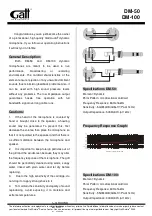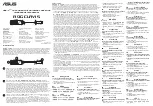
7
1200001549
V7775
248-088
General
The model 515SD Unidyne Microphone is a dual-impedance, cardioid
(unidirectional) dynamic type that provides excellent reproduction of
voice and music. This microphone is highly suited for speech or music
pickup in schools, churches, and meeting rooms, and for sound
reinforcement, broadcast, or recording of small musical groups. Its
unidirectional polar pattern greatly reduces feedback problems,
permitting operation closer than usual to loudspeakers without the
annoying squeal or howl caused by feedback.
The microphone is equipped with a combination On/Off and
Impedance-Selection switch with a lockplate preventing inadvertent
switching to the undesired impedance. A slip-in swivel adaptor is
supplied for the convenience of either handheld or stand-mounted use.
The microphone is supplied without a cable.
Microphone features
●
Wide frequency response designed for faithful, intelligible, and
natural pickup of voice or music.
●
Symmetrical cardioid pickup pattern minimises feedback.
●
Rolled-off low-frequency response reduces proximity effect
(response rise from microphones used closeup).
●
Shock-mounted cartridge for quiet operation, low stand or handling
noise.
●
Combination On/Off and Impedance/Selection switch, with
provision for locking out undesired impedance and locking Switch
On.
●
Slip-in swivel adaptor for easy positioning and for simple handheld
or stand-mounted use.
●
Three-pin professional audio connector, the industry standard, for
maximum interchangeability of cables.
Specifications
Type
- Dynamic
Frequency response
- 80 to 13,000 Hz
Polar pattern
-
Cardioid (unidirectional)-uniform with frequency,
symmetrical about axis (see figure 2)
Impedance
LO Z:
Microphone rating impedance is 150 ohms (170 ohms actual) for
connection to microphone inputs rated at 75 to 300 ohms.
HI Z:
Microphone is impedance is “High” for connection to high-
impedance microphone inputs.
Output level (at 1,000 Hz)
LO Z
HI Z
Open circuit voltage*
-82.5 dB
-59.0 dB
(0.074 mV)
(1.1 mV)
Power level**
-61.0 dB
*0 dB = 1V/
μ
bar ** 0 dB = 1 mW/10
μ
bar
Phasing
Positive pressure on the diaphragm produces positive voltage:
on pin 2 with respect to pin 3 - LO Z;
on pin 1 with respect to pin 3 - HI Z.
Switch
Built-in On/Off, Impedance-Selection switch with lockplate to lock out
undesired impedance, and option to lock switch On.
Connector
Three-pin professional (XLR) type.
Cartridge shock mount
Internal rubber vibration-isolator.
Swivel adaptor
Positive action, adjustable through 90°C from vertical to horizontal, slip-
out removal for handheld use, suitable for mounting on stand with
5
⁄
8
in.
- 27 thread.
Case
Platinum beige enamel die casting with platinum beige ARMO-DUR®
grille and stainless steel screen.
Dimensions
Net weight - 256 grams
Impedance selection and switching locking
The microphone is shipped with the switch locked in the low-
impedance (LO Z) position.
A. To lock the switch “On” in low impedance,
1. Loosen the screw holding the lockplate.
2. Move the switch button to “On”.
3. Slide the lockplate up until the notch butts against the button.
4. Tighten the screw.
B. To change the switch to high-impedance (HI Z) position,
1. Remove the screw holding the lockplate.
2. Move the switch to the “Off” (central) position.
3. Remove the lockplate and replace the screw.
4. Remove the screw at the top of the switch.
5. Place the lockplate in position* with the notch toward the
switchbutton
6. Replace and tighten the screw.
* The lockplate has two positions, just as in low-impedance above:
either locked in high impedance, or locked “On” in high impedance.
Phasing
To test two microphones for proper phasing, connect them to an
amplifier and talk or sing into them while holding them three or four
inches apart. The sound from the speakers should be the same when
talking into either microphone or directly between them if they are in
phase with each other. If the sound drops drastically or if a dead spot
is found when talking between two microphones, the microphones are
out of phase. All microphones should be tested in this manner to ensure
that they are in phase with each other.
Connecting lead
A special lead (type SCI) is available,
RS
stock no. 248-066, and
should be used with this microphone. The lead is terminated in an XLR
connector to mate with the microphone and a 6.35mm 2 pole jack plug
at the other end.
RS Components shall not be liable for any liability or loss of any nature (howsoever
caused and whether or not due to RS Components’ negligence) which may result
from the use of any information provided in
RS
technical literature.
RS
Stock No.
1200001549
V7775
2





















